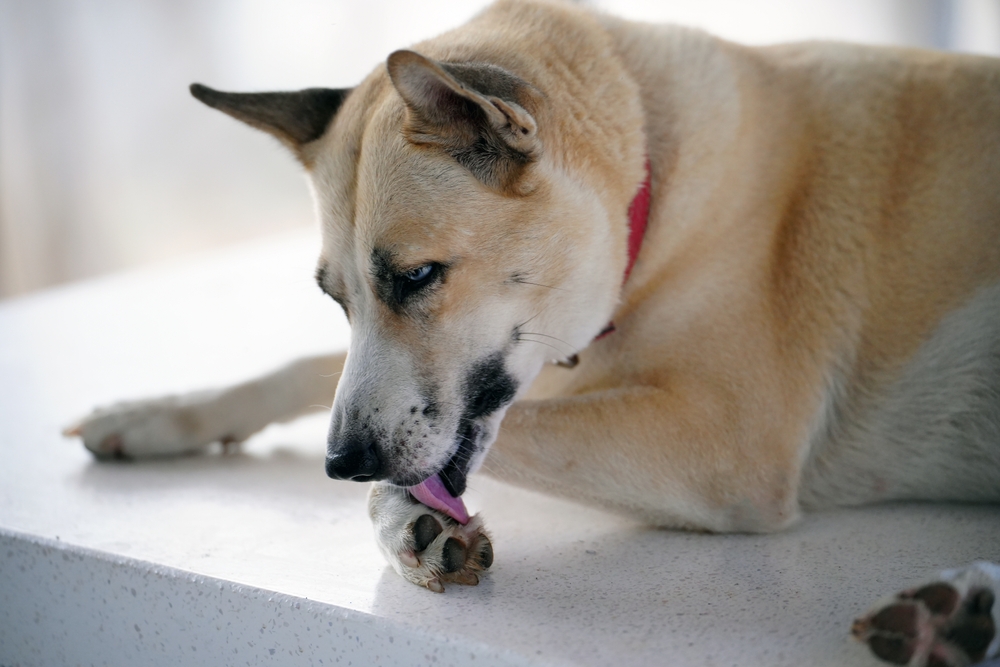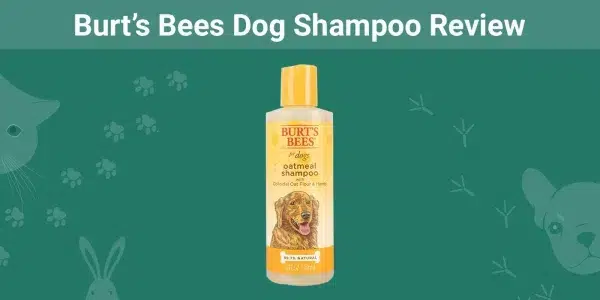In this article
View 6 More +Environmental allergies can be just as problematic for our canine companions as they are for us. While we might associate allergies with runny eyes and sneezing, dogs most commonly show signs such as itching, scratching, licking, and recurrent skin and ear infections. Read on to find out more about environmental allergies, and what you can do to help your dog get relief.

What Are Environmental Allergies?
Environmental allergies occur when substances found outdoors or in the home cause a dog’s immune system to overreact. Usually, these substances — called allergens — are harmless. But if a dog has an allergy to a particular substance in the environment, its immune system mistakenly identifies the harmless substance as a threat and produces special proteins, known as antibodies, that attach to the allergen. This, in turn, triggers the release of histamine and other chemicals into the bloodstream, which leads to itching and other signs of an allergy. Future exposure to that same allergen will trigger this allergic response again.
Allergens can be inhaled, as with pollen, or absorbed through the skin when a dog comes in contact with them.

What Are the Most Common Environmental Allergens for Dogs?
The list of potential environmental allergens is long and varies depending on the plants found in the dog’s particular environment. The most common environmental allergens for dogs include pollens, mold spores, and house dust mites.
- Pollen is an extremely fine powder produced by trees, flowers, grasses, and weeds to fertilize plants of the same species. During the spring, summer, and fall seasons, it’s released into the air and picked up by the wind.
- Molds are microscopic organisms called fungi that are found virtually everywhere, indoors and out. Mold is common in damp areas with little or no airflow. These areas may include your basement, kitchen or bathroom. Mold also grows outdoors in leaf piles, grass, mulch, hay or under mushrooms. Molds reproduce through tiny and lightweight spores that can float through the air like pollen.
- Dust mites are extremely tiny eight-legged bugs that belong to the spider family. They live in mattresses, bedding, upholstered furniture, carpets, and curtains in your home. They feed on the flakes of dead skin shed by people and pets. The proteins found in their urine, feces, and dead bodies cause allergic reactions.
If you’re concerned your dog might suffer from environmental allergies, we recommend you contact a veterinarian for guidance and advice.
Did you know you can speak to a veterinarian without having to travel? Just head over to PangoVet. It's an online service where you can talk to a vet online and get the advice you need for your pet — all at an affordable price!

What Are the Signs of Environmental Allergies?
Some of the most common signs that a dog might have an environmental allergy include the following:
- Persistent itching and scratching
- Redness and inflammation, particularly on the paws, belly, groin, armpits, head, face, and ears
- Recurrent skin infections
- Hot spots: these are areas of the skin that become inflamed, infected, and oozing due to excessive licking and scratching
- Ear infections: recurrent ear infections can be a sign of allergies. Signs include head shaking, scratching at the ears, and an unpleasant odor from the ears
- Excessive licking and biting of the paws
- Hair loss from chronic scratching
- Respiratory issues: although less common, some dogs may develop respiratory signs such as sneezing, coughing, and nasal discharge
Signs are usually seasonal but may be seen all year. Most dogs start to show signs of an environmental allergy between the ages of six months to three years.

What Are the Causes of Environmental Allergies?
It’s thought that allergies are inherited and that predisposed dogs become sensitized to allergens in the environment. Although any breed of dog can be allergic, some dog breeds may be more susceptible to developing allergies. These include:
How Are Environmental Allergies Treated?
The best way to manage an allergy is to avoid exposure to triggers. However, with environmental allergies this isn’t always possible. Fortunately, there are various treatments available to help your pup. Environmental allergies are treated using one or more of the following therapies:
- Topical therapy: Topical treatment is an important component of managing environmental allergies. It can help decrease the need for systemic medication. Medicated shampoos, sprays, and ointments contain ingredients such as steroids, antihistamines, oatmeal, and local anesthetics to help soothe irritated skin. Shampooing has the added benefit of removing offending allergens from the dog’s coat.
- Antihistamines: Antihistamines such as Diphenhydramine (Benadryl®), cetirizine (Zyrtec®), and loratadine (Claritin®) can help reduce itching in some dogs. They’re unfortunately not as effective as other medications at controlling itching.
- Fatty Acids: Omega 3 and 6 essential fatty acids have a mild anti-inflammatory effect on the skin and can help decrease skin dryness. Fatty acid supplementation can sometimes improve the response to steroids and antihistamines.
- Steroids: Steroids are powerful anti-inflammatory drugs that provide rapid relief from allergies. They’re inexpensive and effective at relieving itching. When used short-term, they’re generally safe. However, with prolonged use at high doses, they can cause numerous side effects such as liver enlargement, muscle loss, skin thinning, hair loss, and increased risk of infections.
- Cyclosporine (Atopica®): Cyclosporine is an immune-modulating medication. It works by acting on the immune cells involved in an allergic reaction and reduces inflammation and itching associated with allergies.
- Oclacitinib (Apoquel®): Apoquel® has a new and unique mode of action – it suppresses the enzymes that cause itching and inflammation. Like steroids, Apoquel® is effective at treating itchiness related to allergies. However, unlike steroids, it has few potential side effects.
- Lokivetmab (Cytopoint®): This is a newer treatment option that involves injecting a monoclonal antibody to target and neutralize a key itch-causing protein in dogs. Cytopoint® can effectively block the itch signal and provide relief from itching for 4 to 8 weeks. Unlike steroids, the side effects from this drug appear to be minimal.

Allergy Testing and Hyposensitization
While it’s possible to manage environmental allergies using symptomatic treatment, it is often helpful to perform allergy testing to determine which allergens trigger a reaction. These specific allergens can be used in hyposensitization treatment for your dog.
Hyposensitization involves giving a dog a small quantity of the offending antigen as an injection or oral drops, and slowly increasing the amount over time. The aim of treatment is to decrease the sensitivity of the dog to specific allergens which in turn, decreases the itch. Hyposensitization can also decrease the need for other allergy medication.

How Do I Care for a Dog With Environmental Allergies?
Besides the treatment options mentioned above, there are some things you can do at home to help your allergic dog:
- Vacuum clean and dust your home regularly
- Use a vacuum cleaner with a high-efficiency air (HEPA) filter
- Regularly change air filters
- Use air purifiers during allergy season and keep the windows closed
- Wash your dog’s bedding regularly
- Wipe your dog’s paws and belly with a damp cloth or towel after a walk to remove pollens and other allergens
- Use dehumidifiers to prevent mold in your home
- Feed your dog a diet specially formulated to help reduce signs of environmental allergies in dogs. Antioxidants and other ingredients such as essential fatty acids, zinc, and vitamin A, are added to help support the skin and reduce the inflammatory response.


Frequently Asked Questions
Can Environmental Allergies Be Cured?
Unfortunately environmental allergies can’t be cured, and in most cases require lifelong management. However, with the right treatment, environmental allergies can be controlled and a dog can have a good quality of life.
What Are the Main Causes of Allergies in Dogs?
The three main causes of allergies in dogs include environmental allergies, food allergies, and fleas [flea allergy dermatitis (FAD)].
Can Dogs Be Allergic to Multiple Environmental Allergens at the Same Time?
Yes, it’s entirely possible for a dog to be allergic to multiple environmental allergens.

Conclusion
Environmental allergies occur when a dog’s immune system overreacts to substances found in the environment. These substances – known as allergens – are typically harmless to most dogs. Environmental allergies cause skin-related signs in dogs such as itchiness, redness, hair loss, and recurrent skin and ear infections. The most common environmental allergens for dogs are pollen, mold spores, and house dust mites.
The tendency to develop allergies is often hereditary, which means it can be passed down through genes from parents to their pups. Although any breed of dog can be allergic, some dog breeds may be more susceptible to developing allergies.
Although environmental allergens can’t be cured, they are treatable and controllable in most dogs. Treatment options include medications, topical therapy, desensitization with allergy shots, and specially formulated diets. Treatment is most successful when multiple management approaches are used simultaneously.
- See also: Pyoderma In Dogs
Featured Image Credit: c3cinema, Shuttertstock



















2 Responses
What's the best food for my golden retriever who's 11 she has environmental allergies what is the best food